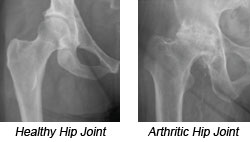Total Hip Replacement
 The hip is an amazing joint. It is one of the strongest weight-bearing joints
in the body and allows you to perform many basic body movements everyday.
The hip is designed as a ball-and-socket mechanism with the head
of the femur joining the socket portion of the pelvis called the acetabulum.
Protective cartilage layers cover the femur and acetabulum absorbing
shock and allowing the ball to glide smoothly within the socket. In addition,
the tissue capsule, which encloses the joint is lined by a membrane that
produces fluid for joint lubrication. Strong band-like tissues called ligaments
reinforce the hip joint and provide strength. The hip joint is designed
to last a lifetime; however, arthritis or other conditions may interfere. Over
time these conditions may become chronic resulting in severe pain and disability
affecting one’s quality of life.
The hip is an amazing joint. It is one of the strongest weight-bearing joints
in the body and allows you to perform many basic body movements everyday.
The hip is designed as a ball-and-socket mechanism with the head
of the femur joining the socket portion of the pelvis called the acetabulum.
Protective cartilage layers cover the femur and acetabulum absorbing
shock and allowing the ball to glide smoothly within the socket. In addition,
the tissue capsule, which encloses the joint is lined by a membrane that
produces fluid for joint lubrication. Strong band-like tissues called ligaments
reinforce the hip joint and provide strength. The hip joint is designed
to last a lifetime; however, arthritis or other conditions may interfere. Over
time these conditions may become chronic resulting in severe pain and disability
affecting one’s quality of life.
When a joint becomes arthritic, degeneration and inflammation of the cartilage, bone and surrounding tissues occurs. Arthritis generally presents later in life and is characterized by the gradual onset of pain, disability, and deformity. However, this process can occur more rapidly in younger individuals, particularly if the joint is deformed or has been injured. The most common form of arthritis is osteoarthritis (degenerative arthritis). Arthritis may also be caused by inflammation (rheumatoid arthritis) or be a result of trauma. Rarely, osteonecrosis (death of the bone) may occur and lead to arthritis. Regardless of the initial type of arthritis, the result is permanent with progressive damage to the cartilage and bone.

As the hip becomes arthritic, the protective cartilage covering that shields the bone from impact begins to deteriorate. Under stress from activity, the bones begin to grind together resulting in bone loss, cyst formation, spurring, and deformity. The person with severe arthritis of the hip may notice pain and stiffness with activities like standing, walking, stair climbing, getting in and out of a car or putting on socks and shoes. One leg may feel shorter than the other and the ability to perform daily activities may be very limited. As the arthritis worsens, an individual may experience pain at rest or at night during sleep.
How do I know if I am a candidate for hip replacement surgery?
Hip replacement surgery is typically indicated for individuals that are no longer benefiting from non-surgical treatments such as medications, therapy, walking aids, injections, and activity modification. When the pain and interference in daily activities is significant and quality of life is diminished, surgery should be considered. A hip replacement can last many years and result in much improvement in overall health and well-being. However, if you are still relatively young, hip replacement may not be the best choice and other surgical options may be considered.
What is total hip replacement?
Total hip replacement surgery has become a common orthopaedic procedure in the United States. It is estimated that more than 120,000 such operations are performed each year. Hip replacements are done to alleviate conditions caused by osteoarthritis, rheumatoid arthritis, fractures, dislocations, congenital deformities, and other hip related problems. The surgery involves replacing the damaged surfaces of the hip with artificial surfaces. The head and the neck of the femur are removed and replaced with a metal or ceramic ball. Traditionally, the damaged socket is lined with a metal-backed plastic socket. Alternatively, metal on metal or ceramic on ceramic designs may be utilized.
Are there other types of hip replacement surgery?
There are two main types of hip replacements currently in use. They are commonly referred to as "cemented" and "cementless." Cemented hip replacements have been performed since the early 1960’s. "Cemented" refers to the acrylic material used to anchor the implant to the bone. This "acrylic cement" functions just like a grout or filler material between the bone and the implant. The second type of replacement is termed cementless because acrylic cement is not used. The implants are designed with a porous- coated surface that is placed directly in contact with the bone. The bone is then able to grow into the porous surface to create a strong bond between the implant and the bone. This type of replacement has been performed since the early 1970’s.
The decision as to which type of replacement is used depends on the surgeon’s preference, the individual’s age, activity level, and characteristics of their bone (as determined by X-rays). Generally, in younger, more active individuals, I favor cementless (porous-coated) implants. More recently, different types of articulating surfaces have been introduced. In addition to the traditional metal ball-plastic socket combination, metal on metal, ceramic on ceramic, and ceramic on plastic articulations can be used.
What are the benefits?
The immediate benefits of total hip replacements are great. The operation usually takes one to two hours; this is much less time than many other operative procedures. The hospitalization time is also relatively short, usually about 3 days, with pain relief occurring with the first week – often immediately after surgery. Full recovery usually takes approximately four months. In most uncomplicated cases, after four months, a patient can expect to be relatively pain-free, have full mobility of his or her hip, walk with minimal or no limp, and lead a normal life.
How long does a hip replacement last?
Most individuals want to know how long their hip replacement will last. The answer is complex. The metal and plastic parts can be subject to wear and loosening just like any other mechanical device. A person’s activity level may also be important. Moreover, the issues of wear and loosening are usually important in younger individuals. Based on many studies, we know that the vast majority of replacements are functioning well 10-15 years after surgery. A small percentage (5-10%) may require another operation to exchange some or all of the parts. Thus over 90% of replacements never need revision.
What are the risks?
There are some risks common to all types of surgery (anesthesia or medical problems) as well as risks unique to hip surgery. These risks include, but are not limited to, anesthesia or medical complications such as heart problems, stroke, pneumonia, or urinary infection. Complications related to hip surgery include: the possibility of infection, bleeding, wound problems, excessive bone formation causing hip stiffness, nerve or blood vessel injury, blood clot formation, leg length inequality, fracture, component loosening, implant failure, metal ion accumulation in the blood, and hip dislocation. The risks of these problems are small (approximately 5%) and they are usually correctable.
The Initial Evaluation
During the initial evaluation, your hip problem and medical history will be reviewed. If you have had previous treatment for your hip pain and/or x-rays, it is important to bring these records with you.
The objective of this first visit is to determine whether hip surgery is indicated. This decision is based upon many factors, which include your degree of pain, severity of limp, the extent of decreased mobility, and your overall dissatisfaction with your condition. Another important consideration is your current health status. After evaluating your x-rays and completing the physical examination, I will be able to discuss with you the relative advantages and disadvantages of a surgical procedure and what the outcomes should be.

